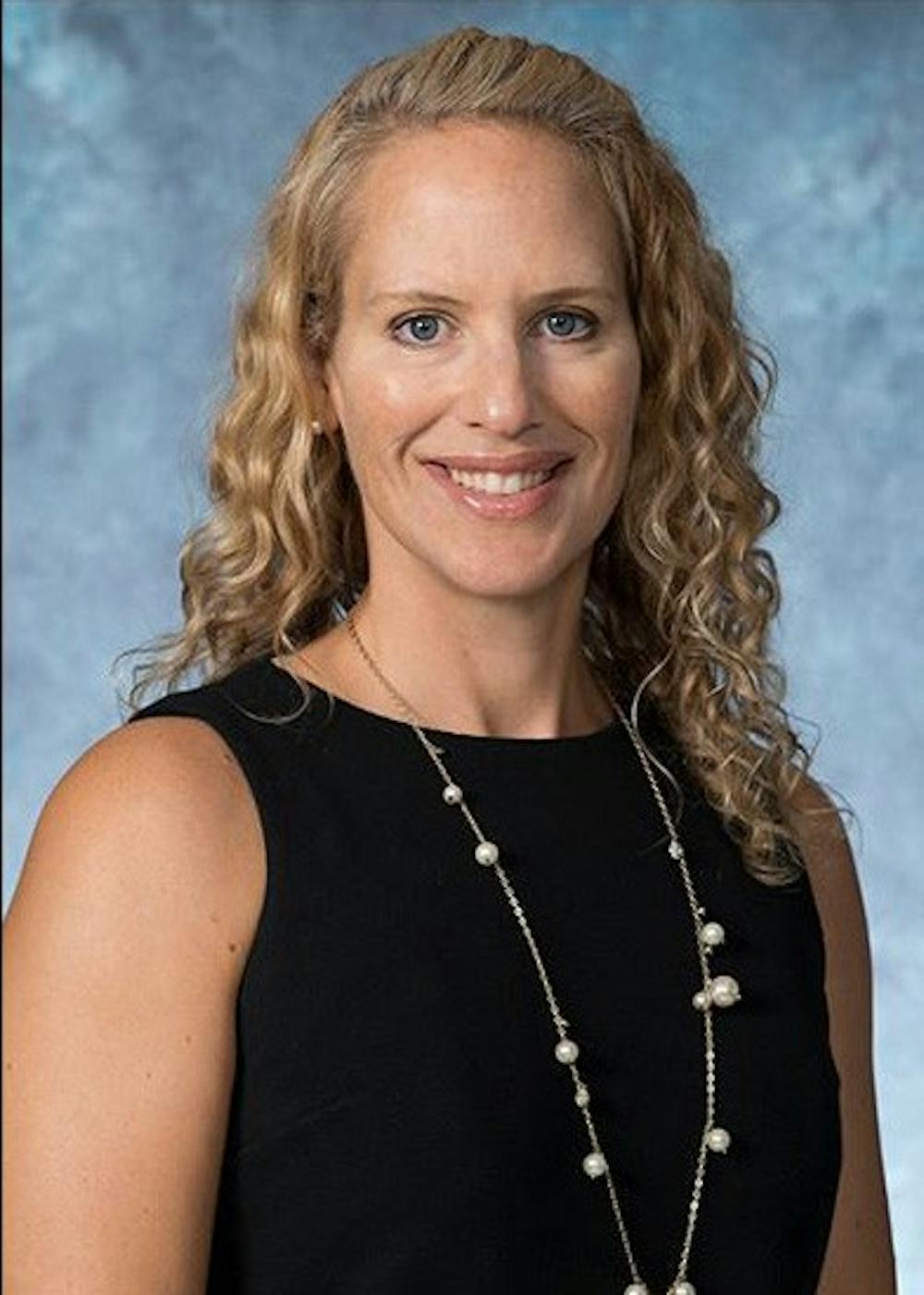Jennifer S. Baker was promoted to the role of director of athletics and recreation in August after her predecessor Alanna W. Shanahan became the new vice provost for student affairs. Baker was previously the senior associate director of athletics and had been in that role since 2017. She is the fifth person to hold the role since 1950.
The News-Letter conducted an interview with Baker to discuss her new role and her vision for the future of Hopkins sports.
The News-Letter: How have your previous experiences, both at Hopkins and elsewhere, influenced how you approach your new position?
Jennifer Baker: Every experience I’ve had has shaped who I am today, and by extension, the work that I’ll do as part of my new role.
I spent the first part of my career in the military and that has probably shaped more of my professional philosophy than anything else. Integrity and accountability are at the core of my leadership style, and people come first in every decision I make. I have a “mission focus,” and it’s important to me that all time and money invested advances us toward accomplishing our mission.
I have had the benefit of being at Hopkins for two years prior to assuming my new role, which has allowed me to better understand our community, our institutional aspirations, and to see firsthand what is possible here at Homewood. These are at the foundation of the work I do now, and part of why it was exciting for me to become the [Athletic Director (AD)]; we have exceptional staff, students and student-athletes, the Hopkins mission is one that resonates, and where we are headed is inspiring.
N-L: How have the interactions you have had with students and student-athletes shaped your view of the student body and their relationship to you?
JB: Our students and student-athletes are exceptional, and I have great respect for their decision to be at Hopkins. Choosing to attend Hopkins, and further, to compete in a varsity sport here, is not the “easy” road. Our students and student-athletes hold themselves to a very high standard, they aspire to excellence in all that they do and they self-select into a community that will challenge them.
In the case of our student-athletes, they have chosen a place where competitive success “on the field” is not mutually exclusive with academic success off of it. This feels familiar and resonates with my own college experience, and accordingly, I always strive to be the source of support and encouragement that was so valuable to me when I was in their shoes.
It’s important to me to be approachable and present with our student population, to let them know that I value the work they put in, that I am grateful for the commitment they have made, and that I’m proud of the way they represent Hopkins.
N-L: How did the previous Director of Athletics and Recreation, Alanna W. Shanahan, influence you? Is there anything you are looking to change now that you are in her former role?
JB: Alanna and I knew each other professionally long before she hired me at Hopkins, and I always greatly admired and respected her. Part of why I was so excited to join the Blue Jay staff was because of the opportunity to work with, and learn from, her.
For starters, Alanna’s experience in college athletics is both deep and broad, and the way in which she approached her work as AD reflected that. Her perspectives were always well-informed, and she was excellent at articulating the reasoning behind decisions.
As a leader, I appreciated her candor and transparency, and her commitment to doing the right thing on behalf of our programs, our people, and our institution. In addition, she asked a lot of questions, she listened well, and she challenged my thinking.
The experience of our students and student-athletes was always her first priority. I certainly hope I can continue to incorporate all that I learned from her as I continue to settle into my new role.
Because we worked so closely together for the last two years, I feel as though I was a part of shaping the way we currently operate, as well as our forward trajectory. For that reason, I don’t anticipate making any significant changes, but rather continuing to build on what we started together.
N-L: Hopkins sports teams had an incredible year last year. How does that success impact you and how will you try to keep it going?
JB: I am incredibly proud of all that our teams achieved last year! That type of success does not happen accidentally, nor simply because of luck — quite the opposite — and it’s a credit to the commitment of our student-athletes, coaches and staff.
That said, I am not one to be content with the status quo, even when that status quo is as remarkable as ours was. I view last year’s achievements as continued inspiration for, and validation of, what is possible for Hopkins Athletics. Sustained success is one of the most elusive things to capture in sport (or across any industry); it certainly is not formulaic, but it’s important to reflect and learn from what we’ve done previously that moved us in the right direction.
My job is to provide our teams the resources they need to achieve at the highest possible level, and I continue to work with our coaches to think creatively about what is needed to stay ahead of the competition.
That is part of the inspiration behind the Blue Jays LEAD program; I truly believe that leadership, and the culture that is reflective of that leadership, is a sustainable competitive advantage for any team. I want to continue to make investments in the holistic development of our student-athletes (mental health, strength and conditioning, personal well-being... ).
In the end, while I would love to win the Directors’ Cup and take home a national championship in every sport, I am far more motivated to see our teams discover how “good” they can really be; I want our student-athletes to reflect on their experience as a Blue Jay and know that they became the best version of themselves while here at Homewood. If we focus on that, the wins will take care of themselves.
N-L: You grew up in the area around Baltimore and there are some Hopkins graduates in your family; is there anything special about being able to play an important role in a university that you have that connection to?
JB: Of course. My dad still wears his class ring every day, and his Hopkins experience is one that has had a lasting impact on him. He was hopeful I would follow in the family tradition and attend Hopkins myself.
It’s important to me that I do this job honorably and in a way that he (and others in my family) can be proud of.
N-L: Is there anything about your new role you especially like? In what ways can you further support student-athletes that you couldn’t in your former role?
JB: I am in this business because I love working with people, so the best part of my new role is actually the best part of my previous role — I get to work with the best staff, coaches, students and student-athletes around! My favorite days are the ones where I am meeting with my staff, out at practices or otherwise engaging with our students.
Moving forward, I hope that I can continue to challenge my staff to think about meaningful ways we can further enhance the experience of our students and student-athletes. That’s not really “new,” but it is something I am increasingly committed to now that I am in the chair.
N-L: What is it like to be able to interact with athletes who are also so academically driven?
JB: I have so much respect for the academic commitment of our student-athletes. I am continually impressed with their desire to learn, to grow and to challenge themselves here at Homewood, and I truly believe that all Hopkins students will change the world in unique and special ways.
Participation in athletics is an educational experience unto itself and complements the more traditional learning that happens elsewhere on campus. It makes me proud to know that time spent as a Blue Jay will shape each and every one of them, and as a result, positively impact their respective communities in the future.
That said — they also keep me on my toes! I always try to think two steps ahead in any interaction I have with them, because I know that they will be doing the same and will always have poignant, thoughtful questions for me. They give me their best, and I enjoy being challenged to return that in kind.
N-L: You initiated the Blue Jays LEAD program while you were in your former position. How have you felt about the success of the program and where do you see it going in the future?
JB: I have been thrilled with the early success of LEAD. Last year, we hosted 18 programs and engaged over 200 of our student-athletes, as well as many of our alumni. This year, we have added 100 additional student-athletes to the program, and the excitement and engagement continues to grow.
Moving forward, I want to collaborate more with campus partners and our alumni. We’ll start that this year with Life Design.
I’d also like to create more focused, a la carte programming that is open to any of our student-athletes as an enhancement to our more traditional curriculum.
Lastly, I’m hopeful to get to a point where personalized, 1:1 leadership coaching can become part of the experience so that our student-athletes can get more direct feedback and support around the areas of their personal leadership they are most compelled to enhance.
We’ve still got lots of work to do in the short-term, but I’m excited about the future possibilities!





